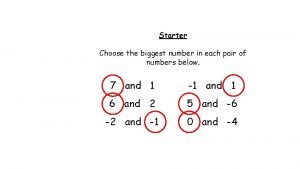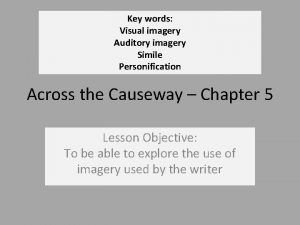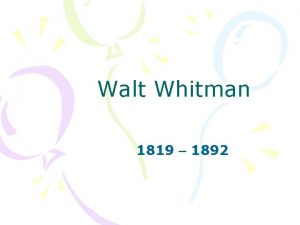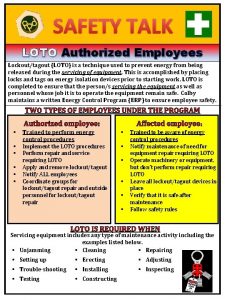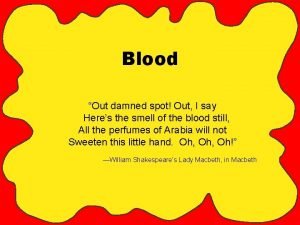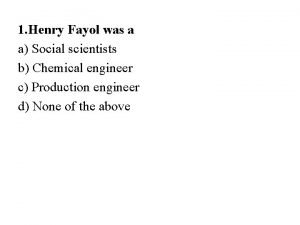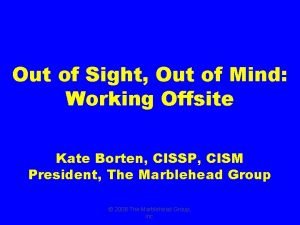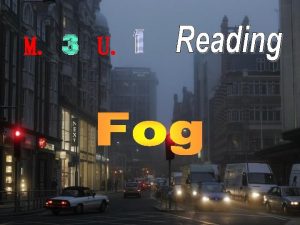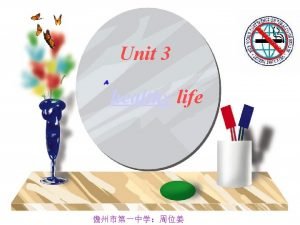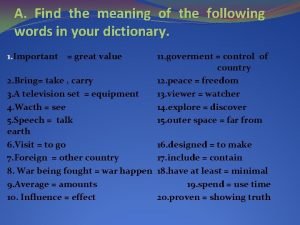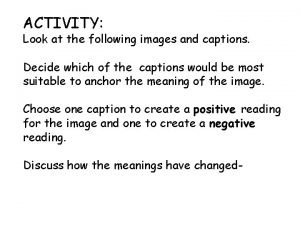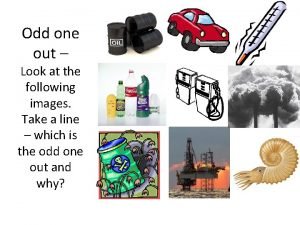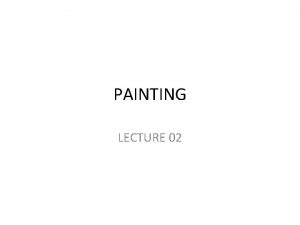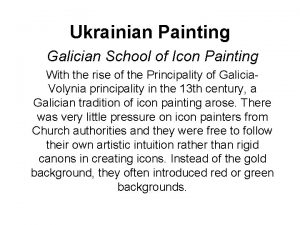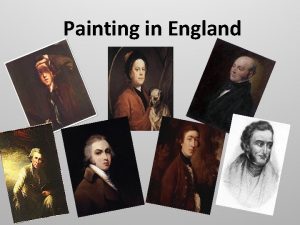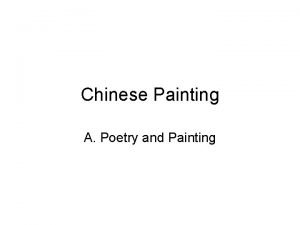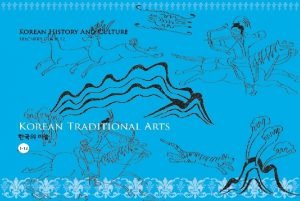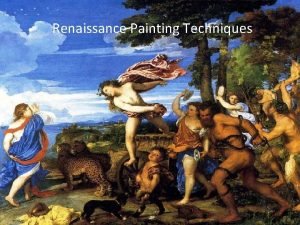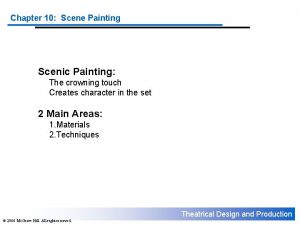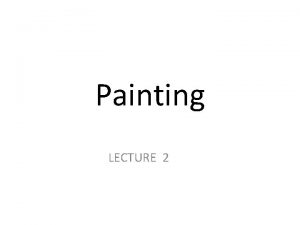G Look at the following painting Pick out
































![The New Austrian Emperor Franz Joseph I [r. 1848 -1916] The New Austrian Emperor Franz Joseph I [r. 1848 -1916]](https://slidetodoc.com/presentation_image/191493636c0a289535dfb2e1004645e5/image-33.jpg)













































- Slides: 78

G Look at the following painting. Pick out the elements of the Romantic Era § Childhood Innocence or common man; Strong senses or emotion; Awe of Nature; Celebration of the Individual; Importance of Imagination

Why is this painting considered Baroque

Baroque or Romantic

The Revolutions Of 1848 “The Springtime of Peoples” Ms. Susan M. Pojer Horace Greeley HS Chappaqua, NY

1848 -The turning point at which history failed to turn. --- George Macaulay Trevelyn [1937]

What is Nationalism G You received a handout when you walked in. Read the definition and answer the questions below: 1. Do you agree with this definition? Why or why not? Is it similar to what was brainstormed in the beginning of class? If not, how is it different? 2. Give two examples from history of former individual loyalty (ie …. the tribe or clan, the city-state or the feudal lord, the dynastic state, the church or religious group).

What did our Enlighenment Philosophers say about Freedom?

G “In order to become truly free, the individual must identify with a larger entity than the family or the community; only a complete relationship with the nation can produce true freedom for the individual. ” (Hegel) G How does this perspective of freedom compare with the philosophes of the Enlightenment? G With whom do you agree (Hegel or the Philosophes)? And why?

After Napoleon European Classes and their Political Stance G Upper Class- Conservatives § Conservatives did not want to share power G Middle Class- Liberals (little government involvement), wanted change but feared radicalism G Lower Class- Radicals (wanted equality)

Pre-1848 Tensions: Long-Term G Industrialization § Economic challenges to rulers. § Rapid urbanization. • Cities are not designed for millions of people leading to overcrowding, disease, and pollution § Challenges to the artisan class. G Population doubled in the 18 c § Food supply problems Malthus G Ideological Challenges § Liberalism, nationalism, democracy, socialism. G Romanticism§ What are the elements of this that would effect how people see the world now?

Pre-1848 Tensions: Short-Term G Agricultural Crises § Poor cereal harvests • prices rose 60% in one year. § Potato blight Ireland • Prices rose 135% for food in one year! G Financial Crises § Investment bubbles burst railways, iron, coal. § Unemployment increased rapidly [esp. among the artisan class]. Working & middle classes are now joined in misery as are the urban and agricultural peasantry!

No Coherent Organized Revolutions G Many different reasons for revolutionary activities. § Reactions to long- and short-term causes. G Competing ideologies in different countries. G Different revolutionary leaders, aims, and goals in different countries. G Some countries had no revolutions: § England. § Russia.

Mapping Activity G With a partner, label the bodies of water, cities and countries, empires and states on the provided map. § A list of what needs to be labeled is on the front page.

Compare and Contrast Chart G You will be assigned one of the following 1848 revolution sites. 1. 2. 3. 4. Italy France (use the 1848 revolution) Germany Austrian Empire G Research to fill out the areas on your chart associated with that revolution.

FRANCE

Prince Louis: Not Too Steady! q Only Thirty Percent of adult males could vote q Still a bourgeoisie dominated society q This is not what the French Revolution was fought for Victor Hugo & Miguel de Girardin try to raise Prince Louis upon a shield. [Honoré Damier’s lithograph published in. Charavari, December 11, 1848].

The February Revolution G Working class & liberals unhappy with King Louis Philippe, esp. with his minister, Francois Guizot [who opposed electoral reform]. G Reform Banquets used to protest against the King. § Troops open fire on peaceful protestors. § Barricades erected; looting. • Link to today in the Ukraine § National Guard [politically disenfranchised] defects to the radicals. § King Louis Philippe loses control of Paris and abdicates on February 24.

Radical Republicans G Provisional Government established to pass socialist reforms G National Workshops. § Centralized stateowned manufacturing plants that guaranteed work § Failed because there was no real work to do. • 200, 000 people signed up in a 4 month period

The Coalition Splits: Mar. -May G The conflicts between liberals & socialists over: G The costs of government social programs. § Did they violate laissez-faire? § Liberty for all men VS. Socialist system G Growing social tensions between the working class & the bourgeois middle class § Pay was less and hours longer than in Britain § Capitalism seen as enemy because it offered no future to the working class § Culture: French citizens saw no problem in physical violence against Parliament

The “June Days” G Class Wars § Working class said that the government had betrayed the revolution. • Workers wanted a redistribution of wealth. § Barricades in the streets. • Victor Hugo’s Les Miserables was based on this event. 10, 000 people were killed in 3 days • G All of Europe was in panic § The Working Class could win, they could overthrow the Bourgeois

Paris: To the Barricades Again!

The 2 nd French Republic (1848 -1852) G General Louis Cavaignac “Butcher of June” assumed dictatorial powers & crushed the revolt. § 10, 000 dead. § A victory for conservatives. G Nov. , 1848 a new constitution provided for: The Republic by Jean-Leon Gerome § An elected President. § A one-house legislature. § Universal Male Suffrage

President Louis Napoleon G The December election: § The “law and order” candidate, Louis Napoleon Bonaparte, § He promised everything to everybody. Was impartial on all sides. § Won 75% of the vote (5 million people) G The New President: § Purged the govt. of all radical officials. • Replaced them with ultra-conservative and monarchists. § Disbanded the National Assembly and held new elections. • Represented himself as a “Man of the People. ” § His government regularly used force against dissenters.

1851 Coup d’Etat G President Louis Napoleon declared a hereditary 2 nd French Empire. G Ruled from 18481871 (he was exiled after the Franco. Prussian War)

When France sneezes, Europe catches a cold

The HAPSBURG EMPIRE

The Austrian Empire: 1830 11 different nationalities within the boarders

Ferdinand I (1793 -1875) G The nature of the Austrian Empire: § Very conservative monarchy [liberal institutions didn’t exist]. G Culturally and racially heterogeneous. G Social reliance on serfdom doomed masses to poverty G Corrupt and inefficient. G Competition with an increasingly powerful Prussia. Therefore, the Empire was vulnerable to revolutionary challenges.

Klemens von Metternich G Chief Minister of Austria G Hero of Hapsburg Austria, organizer of the Vienna Peace Conference after Napoleon G Metternich's ideal was a monarchy that shared power with the traditional privileged classes of society. G Believed there was a natural order of class that was required for order and stability G “Suppressor of Liberty”

Hungary Steps Out G March 3 rd § Louis Kossuth, made a violent speech in the Hungarian Diet. • Creation of a new constitution • Demanded equality between Hungary and Austria • Abolish serfdom • Called for freedom of press, meeting and association § Ignited the Hungarian national spirit and an army began to march towards Vienna to demand their rights

Students and Intellectuals Form a Militia

Vienna, 1848: The Liberal Revolution G March 13 rioting broke out in Vienna. § Citizens wanted basic freedoms and liberalization (removal of government restrictions) § Citizens stormed parliament and responding troops opened fire on the protestors § Riots erupted all over the city, there was mass destruction and chaos G Metternich responded to demands and fled G New constitution was created
![The New Austrian Emperor Franz Joseph I r 1848 1916 The New Austrian Emperor Franz Joseph I [r. 1848 -1916]](https://slidetodoc.com/presentation_image/191493636c0a289535dfb2e1004645e5/image-33.jpg)
The New Austrian Emperor Franz Joseph I [r. 1848 -1916]

The Hungarian Revolution

Tsar Nicholas I (r. 1825 -1855) G He raised an army of 400, 000 in response to a request from Franz Joseph. § 140, 000 put down the Hungarian revolt.

Austrian Revolution ultimately failed G Reasons: § Led by intellectuals and students, no financial backing (who is going to feed/pay the troops) § Kossuth tried to use language to unite the people- only ½ the rebels spoke the language he picked § Franz Joseph was more aggressive than his father and appealed to Russia for help.

Italy

After the Congress of Vienna (1815), the land of Italy was still divided: G Austria ruled the Italian provinces of Venetia and Lombardy. G The Spanish Bourbon family ruled the Kingdom of the Two Sicilies. G Pope controlled the Papal States.

ITALY: LEADERS OF UNIFICATION Mazzini Garibaldi Cavour The Heart The Sword The Brain

ITALY: LEADERS OF UNIFICATION Mazzini: § Formed a nationalist group known as “Young Italy” in 1832. § through coordinated uprisings, the people could drive the Italian princes from their thrones and oust the Austrians from dominance of the Italian Peninsula. § The Italian nationalist movement was called the Risorgimento (“resurgence”) § Spent most of his life exiled from Italy. He inspired through the written word

ITALY: LEADERS OF UNIFICATION Cavour: § Prime Minister of the Kingdom of Piedmont-Sardinia. § Used diplomacy and alliances to increase Piedmont-Sardinia power. § “I have faith that Italy will become one state and will have Rome for its capital. ”

ITALY: LEADERS OF UNIFICATION Garibaldi: § As a young man was a member of Mazzini’s Young Italy and saw Mazzini as “The Master” § Leader of the Red Shirts (Italian nationalist army that gained control of Sicily in 1860).

Italian Unification Man Activity G You and your partners will design a short comic (5 -9 strips). G Your comic will include § IUM character with symbols for the 4 main players in the Italian Unification Movement • Mazzini- the heart or soul • Cavour- the brain • Garibaldi- the sword • Victor Emmanuel II- the crown § Illustrate and explain the 4 unification steps. Use symbols when you can. You may even have a page at the end to explain your symbols • Example: Austria- Baron Von Warbringer – Roman Catholic Church- Pope Verse (who speaks only in bible verses) – France- Friendly Lion or Short Napoleon

Remember comics have heroes and villains. They have a story line They have dialogue

Details G Groups of 2 max G 1 st: You need to research the 4 steps of Italian Unification G 2 nd: You need to outline your hero/hero’s and how they are going to succeed in unifying Italy G 3 rd: In 5 -9 strips you need to illustrate and caption your comic.

ITALIAN UNIFICATION- Step 1 G Agreement between Italy (Cavour) and France (Napoleon III). Napoleon agreed to help drive Austria out of the northern provinces of Lombardy and Venetia. G Cavour provoked a war with Austria. A combined French. Saridinian army won two quick victories against Austria. G They drove Austria out of Lombardia but failed to drive them out of Venetia. G France was given Savoy and Nice in exchange for their help. G The North was now united!

ITALIAN UNIFICATION- Step 2 G Secretly, Cavour started helping nationalist rebels in southern Italy. G In May 1860, a small army of Italian nationalists (the Red Shirts), led by Giuseppe Garibaldi, captured Sicily. G From Sicily, Garibaldi crossed to the Italian mainland marched north. G After Garibaldi took complete control of Southern Italy the people voted to unite with the north.

ITALIAN UNIFICATION- Step 3 G In March 1861, a parliament of all of Italy (except Rome and Venetia), agreed on unifying Italy with Victor Emmanuel as its first king. G Rome was declared Capital of Italy G Three months later Cavour died. Before dying, Cavour purportedly said: "Italy is made. All is safe. "[

ITALIAN UNIFICATION- Step 4 G In 1866, Italy joined Prussia in a war against Austria. When the Prussians won, Italy’s reward was Venetia. G When, in 1870, French troops withdrew from Rome, Italian forces seized Rome, which became the capital of the kingdom. G Italian unity had at last been obtained more by diplomacy and astute timing than by military greatness.

Homework G Use the link on our homepage or a textbook (pg 530) to locate and label the cities on your map

The Nation-State G Supreme political authority rests upon and represents the will of its inhabitants. G Governments found that they could not exercise full power without a sense of acceptance and belonging by their people. G Before 1860 Europe was mainly made up 1. Large empires • Ottomans, Hapsburgs, Romanov 2. Small states • Hanover, Baden, Sardinia, Tuscany, Two Sicilies G Great Britain and France were the only real nation states

The Nation State G For nationalists: § The nation became a kind of secular faith § The nation was a way to higher truth and a better future G Defining Ideas: § United People/ Idea of Community § Others are “Foreigners” § People share a common language, heritage, religion, geographic home § Permanent communities/ Future to Build

The German States

Germany Before Unification 39 Independent States inherited from the old Holy Roman Empire

March Revolution of 1848 G Wanted: § To keep independence § Better working conditions § Introduction of Zollverein (free trade zone) § Basic freedoms (press, assembly, to carry weapons) § Written constitutions (but separate for each state) § Parliament (Frankfurt Assembly)

Germania - 1848 Resulted in the Frankfurt Assembly BUT the Frankfurt Assembly reflected so many different interests that they couldn’t agree. They also had no power to enforce anything they passed Dissolved in May o f the next year. 1949

Frankfurt Assembly Meets

German Unification and Bismarck Otto Von Bismarck 1815 - 1898 Wealthy aristocratic background Prussian Junker Class Commitment to Prussian dominance of a united Germany “Blood and iron” as opposed to parliamentary democracy

Prussia German confederation made up of thirty nine separate principalities– all German speaking Dominant state is Prussia in the north ( Protestant) “Zollverein” Free Trade zone within German States Prussian Junker class – Bismarck on the left Led to industrial revolution boom increasing factories, railroads and communication systems

Bismarck and ‘Realpolitik’ G Realistic Politics based on the needs of the state § Whatever actions necessary to achieve his desired goals. G Power more important than principles G “Blood and Iron” Philosophy “Not by speeches and majority resolutions are the great questions of the day decided—that was the mistake of 1848 and 1849—but by blood and iron. ” § He wanted to eliminate Austrian influence and bring about unification on Prussian terms. § Expand Germany’s Economy and Industrial base with use of its resources.

3 Wars for Unification G 1 st: An 1864 Austrian-Prussian invasion of Schleswig. Holstein led to the end of Danish control of these provinces. Prussia gained a lot of support especially among German nationalists who wanted to see these provinces come under German control.

G 2 nd: 1866 Austro-Prussian War results in Prussian control (Annexes) of several northern German states. § Dissolved the old confederation and establishes a new one dominated by Prussia § Southern states were left independent, form military alliances with Prussia § Last 7 weeks! Prussia was that much stronger and better organized than Austria

3 Wars for Unification G 3 rd: 1870 -71 Franco-Prussian War results in the completion of German Unification § Lasted 6 months but 3 of those months were a siege of Paris § William I of Prussia assumes the role of Kaiser, or emperor of Germany, with Otto Von Bismarck as Chancellor. G Significance/Link of Franco-Prussian War § Prussia won because of its supreme technology and military might • 6 railway lines, invention of breech loading rifle, quick war § Alsace and Lorraine given to Prussia (Germany) § Napoleon III exiled

Germany 1871 The new German Empire emerged as Europe’s foremost military power. Prussia dominated this new German state. ●

United German States G Prussia dominated the new Germany that was called the Second Reich. G The new constitution drawn up by Bismarck was a Federal system. § There are basic laws that apply to everyone and after that “states” can make up their own laws G Each of the twenty-five states had considerable control over their affairs and decided their own form of government; e. g. Bavaria and Saxony were ruled by kings. G Under the constitution there were to be three branches of the Federal government:

The Presidency G The Presidency which was held by the King of Prussia (now German Emperor – Kaiser Wilhelm I). The German Emperor had considerable powers. He had personal control of the armed forces. He appointed and dismissed all ministers including the Chancellor (Bismarck 1871 -1890).

The Federal Council G The Federal Council (or Bundesrat ) represented the different states of the Empire. § It had fifty-eight members. Seventeen were from Prussia, six from Bavaria, four from Saxony. § It had the power to change the constitution. However no change could be made to the constitution if fourteen delegates objected. This in practice meant that Prussia could always stop change.

The Parliament G The Parliament or Reichstag was elected by Universal Male Suffrage (all males over 25 could vote) and Secret Ballot. It voted on the Federal budget and its consent was needed for all legislation. G However, the powers of the Reichstag were limited: § It could not initiate legislation. § The Kaiser (and in effect Bismarck) could dissolve it any time with the agreement of the Bundesrat. § It had no say in the appointment or dismissal of the Chancellor or Imperial ministers. The Imperial Chancellor was appointed by the Emperor and was in charge of foreign policy.

Liberalism Discredited in Germany G Little popular support. G The union of liberals and democrats didn’t last. G Rule of force was the only winner! G There was a massive exodus of liberal intelligentsia. § Militarism, hierarchy, and statism were triumphant! § Capitalists followed suit.

THE AFTERMATH

Why did the 1848 Revolutions Fail? G They failed to attract popular support from the working classes. G The middle classes led these revolutions, but as they turned radical, the middle class held back. G Nationalism divided more than united. G Where revolutions were successful, the Old Guard was left in place and they turned against the revolutionaries. G Some gains lasted [abolition of serfdom, etc. ] G BUT, in the long term, most liberal gains would be solidified by the end of the 19 c: § The unification of Germany and Italy. § The collapse of the Hapsburg Empire at the end of World War I.

The Bottom Line G It looked like the Conservative forces had triumphed. G BUT… § Things had changed forever. § Economic/social problems continued to be constant challenges to the ruling order. § Conservatives would have to make concessions in order to stay in power. § Many of the limited Liberal achievements remained permanent.

The Communist Manifesto Karl Marx Friedrich Engels

Importance of Marx G Until recently almost half the world population lived under regimes that claimed to be Marxist G Believed in Hegelianism (form of dialectical philosophy), opposed by the Prussian Government at the time. § Emigrated to France (1843) § Later expelled from Paris (1844) G Basis of his belief: § Alienated nature of labor under capitalism § Humans are free to develop their nature under cooperative production

Importance of Marx G Communist Manifesto was published in 1848 G Law of development of human history: § that mankind must first of all eat, drink, have shelter and clothing, before it can pursue politics, science, art, religion, etc. ; that therefore the production of the immediate material means, and consequently the degree of economic development attained by a given people or during a given epoch, form the foundation upon which the state institutions, the legal conceptions, art, and even the ideas on religion

Reading- Summary of the Communist Manifesto ‘The history of all hitherto existing societies is the history of class struggle’ ‘What I did that was new was to prove (1) that the existence of classes is only bound up with particular, historic phases in the development of production; (2) that the class struggle necessarily leads to the dictatorship of the proletariat; (3) that this dictatorship itself only constitutes the transition to the abolition of all classes and to classless society. ’ Video Explanation- https: //www. youtube. com/watch? v=0 KUl 4 yf. ABE 4

Communist Manifest Excerpts You can find this on the class website under daily activities. 1. What does Marx say about the history of class struggle? 2. What has happened in modern society? 3. What does Marx say has resulted from capitalism? 4. Who are the Proletariat? 5. What does Marx predict the Proletariat will eventually be able to do?

Class Discussion “The worker becomes all the more poorer the more wealth he creates” G Marx believed that the rich kept the poor in a state of poverty in order to increase their own wealth. Do you believe that this is true of the rich industries today?
 Look down to the left
Look down to the left Figurative language in the song one thing by one direction
Figurative language in the song one thing by one direction Identify the odd man out . water,vegetation,plankton,algae
Identify the odd man out . water,vegetation,plankton,algae Pick out the greater number in each pair
Pick out the greater number in each pair Auditory imagery examples
Auditory imagery examples Sfqnx qdokx sfqmz qdomx
Sfqnx qdokx sfqmz qdomx Which phrase describes neap tides?
Which phrase describes neap tides? Look at activity 1 and answer
Look at activity 1 and answer Activity 1: look at the picture and complete the sentences:
Activity 1: look at the picture and complete the sentences: Look at the picture in activity
Look at the picture in activity Look out for each other
Look out for each other I sit and look out analysis
I sit and look out analysis Put out that light
Put out that light The buzz saw snarled and rattled in the yard
The buzz saw snarled and rattled in the yard Out of sight out of mind psychology
Out of sight out of mind psychology Out out robert frost macbeth
Out out robert frost macbeth Loto safety talk
Loto safety talk Out out by robert frost
Out out by robert frost Time
Time Matthew 11:30 msg
Matthew 11:30 msg Loto
Loto Out, damned spot! out, i say!
Out, damned spot! out, i say! Henri fayol parents
Henri fayol parents Makna out of sight out of mind
Makna out of sight out of mind Bgsu quality systems
Bgsu quality systems Hình ảnh bộ gõ cơ thể búng tay
Hình ảnh bộ gõ cơ thể búng tay Slidetodoc
Slidetodoc Bổ thể
Bổ thể Tỉ lệ cơ thể trẻ em
Tỉ lệ cơ thể trẻ em Chó sói
Chó sói Glasgow thang điểm
Glasgow thang điểm Hát lên người ơi alleluia
Hát lên người ơi alleluia Các môn thể thao bắt đầu bằng tiếng nhảy
Các môn thể thao bắt đầu bằng tiếng nhảy Thế nào là hệ số cao nhất
Thế nào là hệ số cao nhất Các châu lục và đại dương trên thế giới
Các châu lục và đại dương trên thế giới Công thức tính độ biến thiên đông lượng
Công thức tính độ biến thiên đông lượng Trời xanh đây là của chúng ta thể thơ
Trời xanh đây là của chúng ta thể thơ Mật thư tọa độ 5x5
Mật thư tọa độ 5x5 101012 bằng
101012 bằng độ dài liên kết
độ dài liên kết Các châu lục và đại dương trên thế giới
Các châu lục và đại dương trên thế giới Thơ thất ngôn tứ tuyệt đường luật
Thơ thất ngôn tứ tuyệt đường luật Quá trình desamine hóa có thể tạo ra
Quá trình desamine hóa có thể tạo ra Một số thể thơ truyền thống
Một số thể thơ truyền thống Cái miệng bé xinh thế chỉ nói điều hay thôi
Cái miệng bé xinh thế chỉ nói điều hay thôi Vẽ hình chiếu vuông góc của vật thể sau
Vẽ hình chiếu vuông góc của vật thể sau Biện pháp chống mỏi cơ
Biện pháp chống mỏi cơ đặc điểm cơ thể của người tối cổ
đặc điểm cơ thể của người tối cổ Thế nào là giọng cùng tên? *
Thế nào là giọng cùng tên? * Vẽ hình chiếu đứng bằng cạnh của vật thể
Vẽ hình chiếu đứng bằng cạnh của vật thể Fecboak
Fecboak Thẻ vin
Thẻ vin đại từ thay thế
đại từ thay thế điện thế nghỉ
điện thế nghỉ Tư thế ngồi viết
Tư thế ngồi viết Diễn thế sinh thái là
Diễn thế sinh thái là Các loại đột biến cấu trúc nhiễm sắc thể
Các loại đột biến cấu trúc nhiễm sắc thể So nguyen to
So nguyen to Tư thế ngồi viết
Tư thế ngồi viết Lời thề hippocrates
Lời thề hippocrates Thiếu nhi thế giới liên hoan
Thiếu nhi thế giới liên hoan ưu thế lai là gì
ưu thế lai là gì Sự nuôi và dạy con của hươu
Sự nuôi và dạy con của hươu Sự nuôi và dạy con của hươu
Sự nuôi và dạy con của hươu Sơ đồ cơ thể người
Sơ đồ cơ thể người Từ ngữ thể hiện lòng nhân hậu
Từ ngữ thể hiện lòng nhân hậu Thế nào là mạng điện lắp đặt kiểu nổi
Thế nào là mạng điện lắp đặt kiểu nổi Take a look at the following pictures
Take a look at the following pictures Look at the following image and write predictions
Look at the following image and write predictions Task 2 look at the following pictures what are they doing
Task 2 look at the following pictures what are they doing Vacation denotation and connotation
Vacation denotation and connotation Look at the picture and answer the question
Look at the picture and answer the question Find the meanings of the following words
Find the meanings of the following words Look at the pictures ask and answer
Look at the pictures ask and answer Look at the picture then answer the following question
Look at the picture then answer the following question Look at the following images
Look at the following images Look at the following shapes try to form a body of a fish
Look at the following shapes try to form a body of a fish Fractional distillation viscosity
Fractional distillation viscosity What is this picture
What is this picture



